This is a free fortnightly newsletter about the New Zealand Net.
If you would like to be notified by email when a new edition is published, please subscribe here.
Browse our Newsletter Archive and List of Net Tips.
Featured key
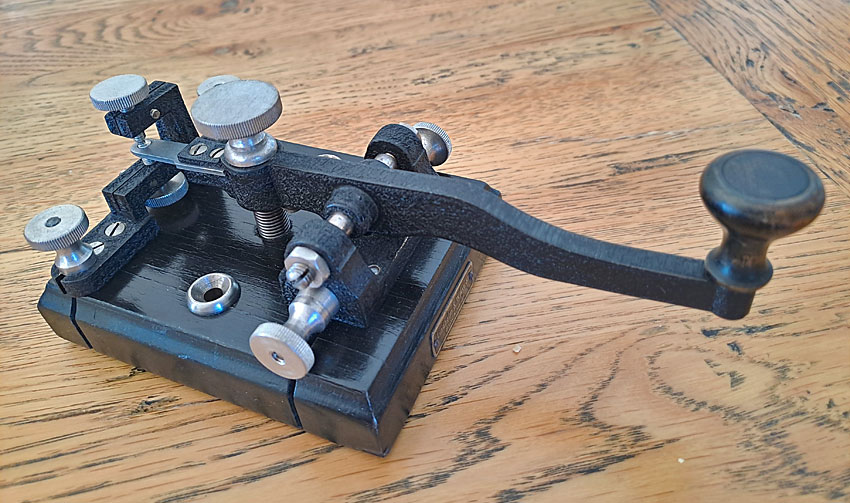
Lindholm & Wikström Swedish Post Office key. Photos VK3QB
By Chris VK3QB
In 2002 my former employer (IBM) sent me to SM-land for seven weeks. That short project turned into a four-year international assignment.
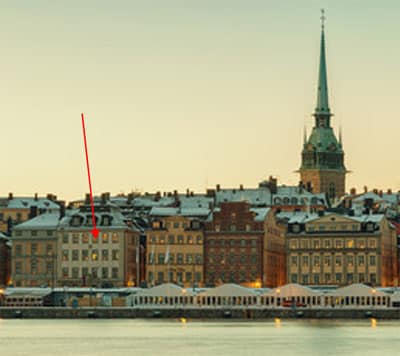 Working and living in Sweden and northern EU was fantastic. I spent about three months living in an old waterfront apartment (built c1644) in Gamla Stan (the Old Town) just south of downtown Stockholm. The red arrow indicates my apartment – a wonderful place to live, but not at all amateur radio friendly.
Working and living in Sweden and northern EU was fantastic. I spent about three months living in an old waterfront apartment (built c1644) in Gamla Stan (the Old Town) just south of downtown Stockholm. The red arrow indicates my apartment – a wonderful place to live, but not at all amateur radio friendly.
On weekends, I often wandered the streets, looking in the stores and admiring the architecture. I recall picking through an antique store in Gamla Stan and coming across the old Morse key pictured above. I scooped it up for about 500 Swedish Kroner (about US$60 at the time) and packed it away for future use.
On returning to VK in 2006 I dug the old key out and did a bit of online research. It turns out the key was made by Lindholm & Wikström between 1878 and 1905.
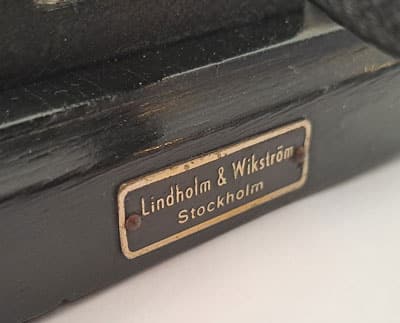 This style of key was designed by Anton Öller in 1857. Two of his machinists, Lindholm and Wikström broke away from Öller in 1878 and started their own business. Another Öller employee, Lars Magnus Ericsson, formed his own company in 1876, repairing telegraph equipment. His company went on to develop telephone equipment and is now a global telecommunications company.
This style of key was designed by Anton Öller in 1857. Two of his machinists, Lindholm and Wikström broke away from Öller in 1878 and started their own business. Another Öller employee, Lars Magnus Ericsson, formed his own company in 1876, repairing telegraph equipment. His company went on to develop telephone equipment and is now a global telecommunications company.
The design of this key was very popular and was used by various Scandinavian and UK companies and defence forces for over 120 years. A popular variant known as the Swedish Pump Key was produced by Lennart Pettersson (c1960) and today we have a modern version, the Blade by Begali.
My key was well worn, corroded in places, and with a slight bend in the lever. On occasion I would use it, but it needed (and deserved) some professional attention.
This year I sent the key to Kees van der Spek VK1KVS for assessment and reconditioning. Kees is well known and respected for his knowledge and skill in reconditioning old Morse Keys. A few weeks later the key was returned, looking fantastic (but still original) and operating far smoother than when I’d shipped it to Kees.
This key will grace my radio shack for many years to come. Operationally, I prefer using a bug or paddles, but for special events I’ll reach for this key and think about its rich history.
Quick notes
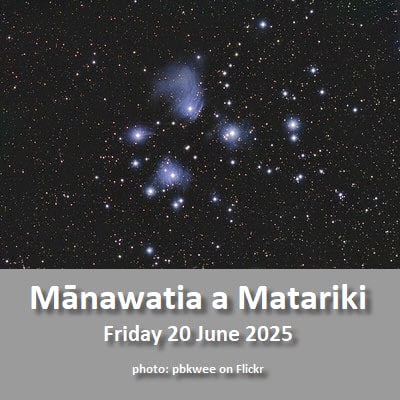 Best fist announced. During Straight Key Night on 8 June, operators were asked to nominate their choice for the Bruce Scahill Best Fist Award. The winner was our Tuesday net controller, Grant ZL2GD. Other nominees were ZL1AJY, ZL1NZ, ZL2AUA and ZL4GW.
Best fist announced. During Straight Key Night on 8 June, operators were asked to nominate their choice for the Bruce Scahill Best Fist Award. The winner was our Tuesday net controller, Grant ZL2GD. Other nominees were ZL1AJY, ZL1NZ, ZL2AUA and ZL4GW.
At least 18 New Zealand stations were heard on the air during SKN, plus there were 8-9 participating in Australia (see more about that, later in this newsletter). Propagation continues to be extremely poor and no one reported making a trans-Tasman contact during this SKN.
Starlink satellites are leaking radio signals that may ruin astronomy, according to a report in New Scientist. There are thousands of Starlink satellites in orbit so this is one very big RFI problem. Does anyone know where we can find a Radio Inspector these days?
Long-wave station SAQ marks 100 years

Switchboard. Photo: the Alexander Association
On 2 July 1925, Grimeton Radio was officially inaugurated, although the station had begun handling traffic on 1 December the year before.
Guests at the official opening included the king of Sweden, Gustav V; the inventor of the amazing 200kW alternator and the massive six- tower antenna, Ernst FW Alexanderson; and the vice president of Radio Corporation of America, David Sarnoff. They watched as a message was sent to US president Calvin Coolidge via a station at Riverhead, Long Island, New York. The American president replied and assessed the new radio installations as crucial for relations between Sweden and the USA.
A century has passed but, thanks to a team of volunteers, the mighty Alexanderson alternator still spins for special occasions on 17.2 kHz CW.
During the anniversary celebration, you can watch SAQ in action via a video livestream, starting at 0830 UTC.
One of the cool things about SAQ, is that its frequency is in the audio range, and there are online instructions for listening by connecting an antenna to the mic input of a computer running an audio editing program. Wouldn’t that be fun? One tip though: if you want to build a dipole, bear in mind that a half-wave at 17.2 kHz is about 8700 metres. 🙂
International Dog Day on the air

Certificate for the IDD top award: the Full Kennel
By Chris G5VZ
To mark International Dog Day (held every year on 26 August), I shall be operating GB0DOG during all of August. This is my third year as an IDD station, and my operating will be CW-only.
David G4YVM will be on the air as GB4DOG. We also have a number of European stations – including Hanz YL3JD, who started the IDD on the air some years ago, with YL1DOG – and a US-based team operating K2D.
Caryn KD2GUT, who is organising the US team, says: “International Dog Day (and, in the US, National Dog Day) was created by US pet advocate Colleen Paige as a day to recognise the needs of society’s unwanted and cast-off dogs and affirm the commitment to adopt, donate or raise awareness of their special needs.”
For radio hams, there are awards at four levels. The basic, called the Perky Puppy, is awarded for contact with just one participating station. The top award, for contacting all stations, is the Full Kennel. Hamlog Online will be managing the awards for us.
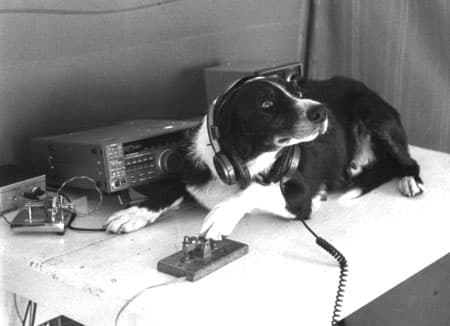
Photo: ZL1AJY, during Field Day a long time ago
More info:
International Dog Day
dogdayradio.org
hamlog.online/idd/
But what about the cats?
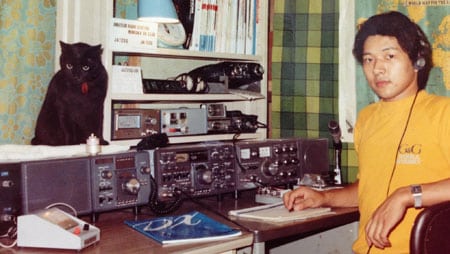
Tadafumi Kimura JH7CSU with his feline helper, c1980
Fear not cat lovers, International Cat Day is held every year on 8 August – and there’s an amateur radio event for it too.
More info:
International Cat Day
catdayradio.org
hamlog.online/icd/
While I think of it, any errors you spot in this newsletter should be blamed on our cats, two of which are trying to occupy the keyboard as I type this.
Morse Mania winter activity on 40
A new CW event kicked off a couple of days ago but there’s still lots of time to get involved.
Chris VK3QB has organised Morse Mania, which takes place on 40 metres. The objectives are:
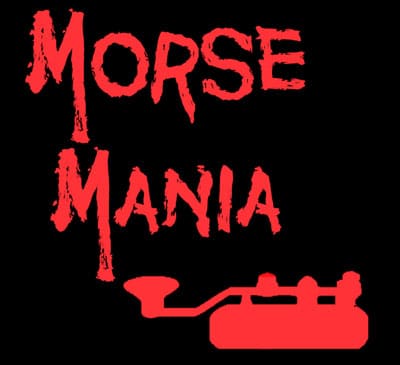
- to promote regular on-air QSOs primarily between VK and ZL operators. Other DX operators and contacts are welcome.
- for CW operators to have as many QSOs as possible whilst meeting the minimum criteria for a QSO.
- to provide an event that meets the needs of different types of CW operators.
- to use these sessions to build on existing skills and satisfy your own goals.
Participants are encouraged to notify the Event Administrator of their personal goals prior to the event.
This is an eight-week event with one-hour sessions on Tuesdays, Thursdays, and Sundays from 0930 to 1030 UTC.
Three sessions per week offers greater flexibility for people who may otherwise be unavailable at a single weekly session. It also gives those with higher manic levels the opportunity to be more active without obtaining any competitive advantage.
- Start date: Tuesday 17 June 2025
- End date: Sunday 10 August 2025
Mugshot
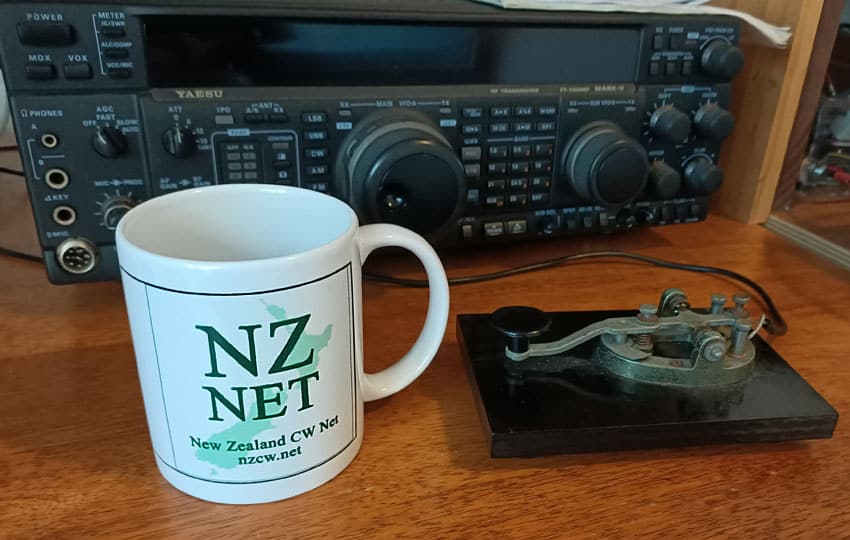
Photo: VK4PN
Australian stations join SKN
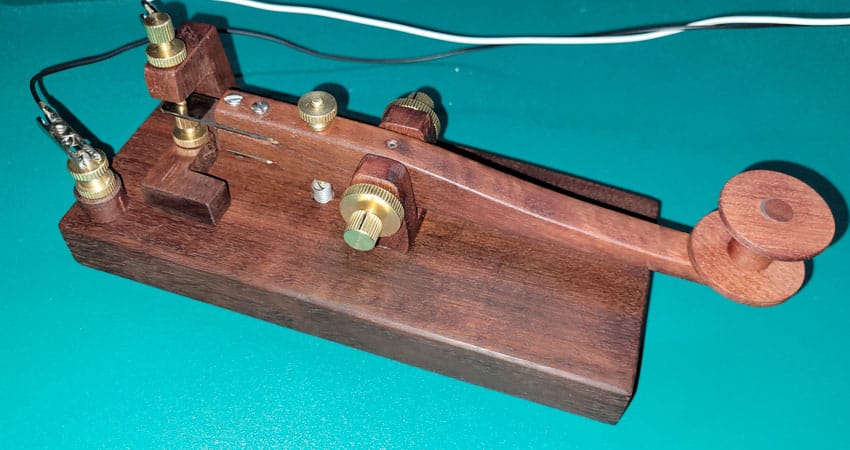
Andy VK3OU made this fine looking straight key
By Chris VK3QB
I had been in touch with Neil ZL1NZ, just prior to New Zealand Straight Key Night on 8 June, and told him I would like to promote the event here in VK. Looking at the logs received I’d say we had about eight or nine people participate – which is great for 80 metres.
Pretty much everyone reported bad conditions, but nonetheless a number of operators reported working six to eight stations – all VK. I don’t have any reports of VKs working ZLs for SKN.
A few ops sent me reports:
From Andy VK3OU:
Here’s my QSO list for SKN: VK2GBR, VK1CT, VK3BSE, VK3VB, VK5GG, VK3QB.
Not a single ZL heard, I’m afraid. But that might be due to my heavily compromised antenna for 80m.
As for the key, I gave my new home-brew disaster a shake-down run (see photo above). It’s modelled on a Marconi PS213A, and is made from a single red gum block. All with hand tools (and half a bottle of Icelandic vodka). A bit crude, but I think I’ve dialed it in now, and boy-howdy, does it FLY!
 From Sam VK3NOP:
From Sam VK3NOP:
I didn’t know SKN until people talked about it on Fists Downunder Discord on the day.
When I quickly tuned my ATU for 3.5MHz, It was already 6:48PM in Melbourne time, only 12 minutes remaining.
I heard a few VK stations making contact, but no ZL stations at all. Eventually I had a QSO with VK3QB.
It was from that QSO that I learned there was a type of straight key called “pump”. When Chris asked me what key I was using. I was like, “ah? what is the specific type of my straight key?” But eventually I just answered “(usual) straight key” as I don’t know if mine had a specific name.
It was a short and fun event and proved my trapped and loaded antenna worked for 80m.
[Sam’s key is a Peoples Liberation Army K4 from China. – Ed.]
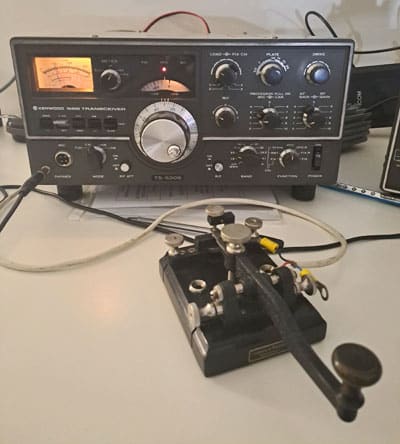 From Chris VK3QB:
From Chris VK3QB:
Conditions were rough, and not helped by me deciding to use my reconditioned TS-520S without a narrow filter. I bought a filter from Japan but haven’t gotten around to installing it.
I didn’t hear any ZLs, but managed five QSOs with stations in VK3, 2 and 5. This was the first time I’d used the Swedish Pump Key since it was reconditioned, and while it was a pleasure to operate, my lack of practice showed up!
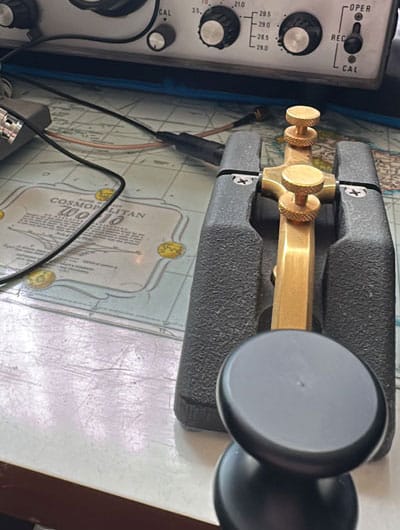 From Phil VK3VB:
From Phil VK3VB:
The NZ Straight Key Night was quite an enjoyable hour. Unfortunately no QSOs across the ditch, but it was good to get on 80 metres and have some contacts with the straight key – for me this was the Begali Spark.
I managed four QSOs for the hour, all being VK2 or VK3. I did hear VK4DRK and VK2GBR, but did not manage a QSO with either.
As far as the station. I fired up the TS520s and ran that into an 80m End Fed Half Wave. The antenna starts off vertically, helically wound up a 10m squid pole.
I am starting to really like the 1-hour “activity” style events, even though traditionally I leaned towards longer events. It seems to attract more stations and concentrate the activity.
Video: Bletchley Park – The Y stations, part 1
Net tip: QNM
We continue our look at Q signals with QNM. This signal is only used by the Net Control Station (NCS). It means: “You are interfering with the net. Stand by.”
We don’t hear QNM used often, but it’s quite important to remember it. Interference comes in many forms, and can even be caused by someone trying to be helpful, as in the following hypothetical situation:
A weak station attempts to check in using the sine “Y”.
NCS does not hear them.
Someone else (the “helper”) then repeats the sine “Y”, thinking they are assisting NCS.
The weak station hears the helper’s “Y” and believes they have been acknowledged by NCS, so they start their check-in.
At the same time, NCS, having heard a “Y” transmitted by the helper, sends “Y” over the top of the weak station which is trying to check in.
NCS still hears nothing, so they carry on with other net business, possibly doubling with the weak station.
On NZ Net, the NCS will almost always call for a QNG1 at some stage, and will also ask for relays after sending the list of check-ins. So the weak station will have two opportunities to be picked up.
If a “helper” believes that the weak station’s QNI cannot wait, they should send their own sine, wait for acknowledgment from NCS, and then tell NCS “QSP QNI FM Y”. NCS will then ask the “helper” to relay.
Did we skip QNL in this series of Net Tips? No, it was covered along with its mate, QNH, in NZ Net News 157.
The A-Z of Q Signals

A well-run CW net is a lovely thing to experience. Communication between stations is quick and concise, and the net business is conducted with minimal time wasted.
As CW operators, we have many techniques to communicate quickly and efficiently. And if we know and use these techniques, we can often match or exceed the speed and accuracy of voice communication.
One of our most important tools is the set of Q Signals (or Q Codes), and in this series we look at the “essential” ones, in alphabetical order.
Advertising archive

Break-In magazine, Sep 1983
Suggestions?
If you have suggestions on how to make the NZ Net better, or things you’d like to see covered in these newsletters, please contact ZL1NZ. Articles and photos will be gratefully received!
Thanks for reading, and I hope to hear you soon on the NZ Net!
—
Neil Sanderson ZL1NZ, Net Manager
New Zealand Net (NZ NET)


